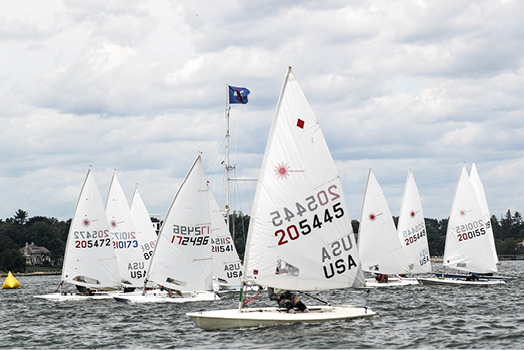By David Dellenbaugh

When the breeze is shifting steadily in one direction, you need a different strategic approach than when it’s oscillating. Instead of playing the middle, head toward one side. Of course, your gameplan will depend a lot on how much confidence you have in your wind predictions. If you’re only 50% sure that the wind will veer right, for example, you probably wouldn’t want to sail too far into the corner. Here are some strategy ideas:
Study the wind.
You don’t want to play the wind as persistent when it’s really oscillating, so do your homework before the start. Listen to forecasts, check out the wind in different parts of the course, and watch for trends in wind direction. Allow plenty of time for observing the wind – otherwise what seems like a persistent shift might really be a long oscillation. Keep looking around after the start. With boats spread across the first beat, it’s a great time for visualizing persistent shifts.
Look for land and current.
When you have land near one side of the course you will often experience a “geographic” shift as you sail toward shore. Because this shift is more pronounced as you get closer to the land, treat this as a persistent shift. The same is true when you have a difference in current across the course. As you sail into more or less current, this will make the wind direction shift more and more one way, just like a persistent shift. Check out these effects before the start.

When the wind is shifting persistently you’ll notice it first at one edge of the fleet, so keep your eyes on the boats that are farthest to each side. What you’ll see is a fanning effect as the shift spreads across the fleet. That is, the boats closest to the direction of the new shift will be sailing the highest angles, while the boats farthest from it are still sailing lower angles. © Mary Alice Fisher/maryalicefisher.com
Consider the small picture.
Persistent shifts are often caused by weather systems or by thermal influences that make the wind shift gradually in one direction. Keep in mind, however, that your average windward leg is relatively short. Even if the wind is supposed to shift steadily right all day, for 30 minutes of your first beat the wind might be steady or oscillating, or it may even shift slightly to the left.
Evaluate the tradeoffs.
When you think the wind will shift persistently, you should generally sail directly toward that shift. But how much would you be willing to give up to get there? Would you start at the unfavored end of the line? Sail in bad air for five minutes? It depends on how sure you are that the wind will shift and how far you think it will go. For example, if you believe the wind will shift only 5° right during your first beat, you might not want to start at the RC boat end of the line if the pin is favored by more than 5°.
Sail fast into the shift.
When you’re pretty sure the wind will shift persistently, go that way quickly. Having a lane of clear air in this direction can be invaluable, so look ahead and defend your lane aggressively. If possible, sail slightly faster than usual so you get to the shift sooner and maximize leverage.
Look for leverage.
When the wind shifts, the boat that’s closer to the shift will gain, and the amount of her gain is proportional to her lateral separation, or leverage, from other boats. In an oscillating breeze, you don’t want too much separation because the wind will always shift back the other way. With a persistent shift, however, more leverage can lead to bigger gains.
Prepare to ‘bite the bullet.
’ Personally, I never like crossing behind other boats because this is an admission that I’m behind. However, if you want to fare well in persistent shifts, you must be willing to do this. Forget about other boats and do whatever is the right thing from the position you’re in.
Don’t overstand the mark.
Boats sailing farthest into a persistent shift usually come out ahead. However, it’s possible to go too far. The wind will probably keep shifting after you tack for the mark. Overstand, and you’ll lose boats that tacked sooner.
Think about the next leg.
If the wind has shifted persistently during the first beat, it will affect your next leg (a reach or run). Think ahead about whether you’ll go high, low, or do a jibe set.
This article originally appeared in David Dellenbaugh’s Speed & Smarts, The newsletter of how-to tips for racing sailors. If you want to sail faster and smarter, log onto SpeedandSmarts.com.



